| | | OFFLINE | | Post: 22.182
Post: 4.809 | Registrato il: 28/08/2005
Registrato il: 20/01/2009 | Administratore | Utente Master | |
|
 GENERAL AUDIENCE TODAY
GENERAL AUDIENCE TODAY
Catechesis on St. Robert Bellarmine
Doctor of the Church
The Holy Father today focused his catechesis on St. Robert Bellarmine, the fourth in the remaining eight Doctors of the Church that he had failed to cover in previous catechetical cycles covering outstanding figures of the Church from antiquity to the Middle Ages, which included the first 25 Doctors of the Church from St. Ambrose (340-397) to St Catherine of Siena (1347-1379).
To complete his catecheses on all 33 Doctors of the Church, he has since presented St. Teresa of Avila (1515-1582), St. Peter Canisius (1521-1597), St. John of the Cross (1542-1591), and today, St. Robert Bellarmine (1542-1621).
The remaining four are St. Lawrence of Brindisi (1559-1622), St. Francis de Sales (1567-1622), St. Alphonse Liguori (1696-1787), and St. Therese of Lisieux (1873-1897).
Here is how he synthesized the catechesis on St. Robert Bellarmine, after which he expressed his condolences for the earthquake victims and residents of Christchurch, New Zealand.
Our catechesis today deals with Saint Robert Bellarmine, the great Jesuit theologian and Doctor of the Church.
In the period following the Council of Trent, Saint Robert taught theology, first at Louvain and then in the Roman College. His most famous work, Controversiae, sought to address the issues raised by Protestant theology from a serene historical and theological perspective, but his most popular work remained his brief catechism of Christian doctrine.
He also served as spiritual father to the Jesuit students of the Roman College, including Saint Aloysius Gonzaga. Saint Robert was created a Cardinal by Pope Clement VIII, and made Archbishop of Capua, where he spent three years in preaching and pastoral activity before being recalled to Rome and the service of the Holy See.
In his later years, he composed a number of works of spirituality which reflect his deep Ignatian formation, with its stress on meditation on the mysteries of Christ and the loving imitation of the Lord.
May the example of Saint Robert Bellarmine inspire us to integrate our work and our pursuit of Christian holiness, to grow in closeness to God through prayer, and to contribute to the Church’s renewal through our own inner conversion to the Lord and the truth of his word.
A new and powerful earthquake, even more devastating than the one last September, has struck the city of Christchurch, in New Zealand, causing considerable loss of life and the disappearance of many people, to say nothing of the damage to buildings.
At this time, my thoughts turn especially to the people there who are being severely tested by this tragedy. Let us ask God to relieve their suffering and to support all who are involved in the rescue operations. I also ask you to join me in praying for all who have lost their lives.
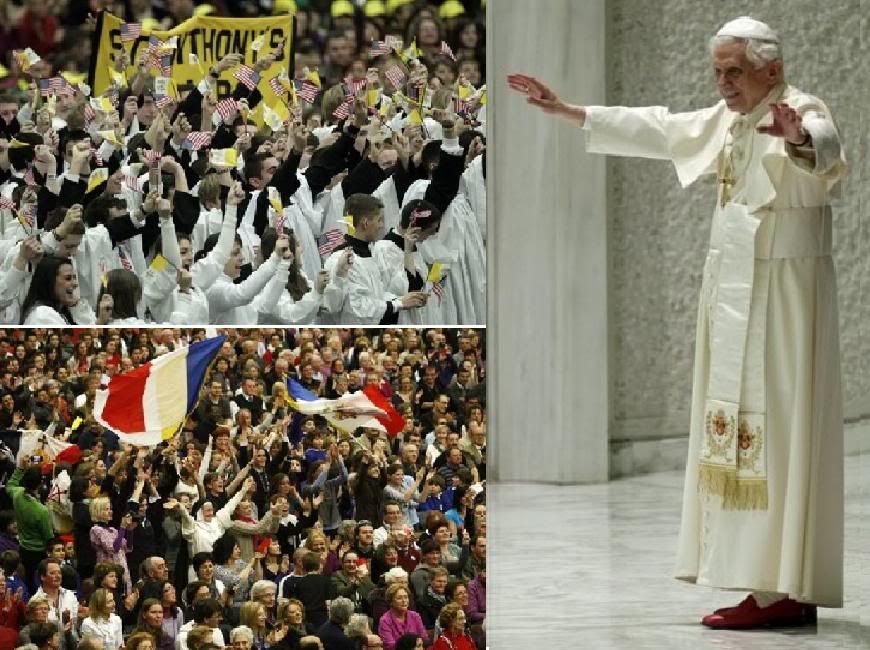
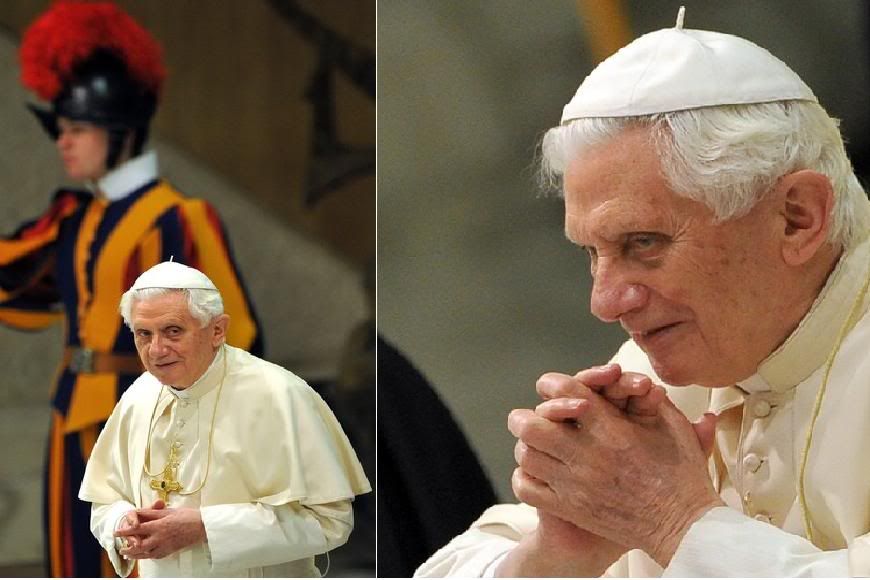 St. Robert Bellarmine and
St. Robert Bellarmine and
reforms in a time of crisis

23 FEB 2011 (RV) - Pope Benedict XVI continued his series on the great Doctors of the Church, turning this Wednesday to the 16th Jesuit theologian, Saint Robert Bellarmine, an outstanding figure of a troubled age in which "a serious political and religious crisis provoked a split between entire nations and the Holy See".
"His Disputationes (Controversies) are still a valid point of reference for Catholic ecclesiology", said the Holy Father. "They emphasise the institutional aspect of the Church, in response to the errors then circulating on that topic"
"Yet Bellarmine also threw light on invisible aspects of the Church such as Mystical Body, which he explained using the analogy of the body and soul, in order to describe the relationship between the interior richness of the Church and her visible exterior features.
"In this monumental work, which seeks to categorise the various theological controversies of the age, he avoids polemical and aggressive tones towards the ideas of the Reformation but, using the arguments of reason and of Church Tradition, clearly and effectively illustrates Catholic doctrine.
"Nonetheless", the Pope added, "his true heritage lies in the way in which he conceived his work. His burden of office did not, in fact, prevent him from striving daily after sanctity through faithfulness to the requirements of his condition as religious, priest and bishop...
"His preaching and catechesis reveal that same stamp of essentiality which he learned from his Jesuit education, being entirely focused on concentrating the power of the soul on the Lord Jesus, intensely known, loved and imitated"....
Before today's audience, the Holy Father blessed a statue of St. Maron, founder of the Maronite Church which is particularly widespread in Lebanon and Syria.
The 4.5-metre high Carrara-marble statue now occupies the last empty niche on the outside wall of St. Peter's Basilica, is the work of Spanish sculptor Marco Augusto Duenas.
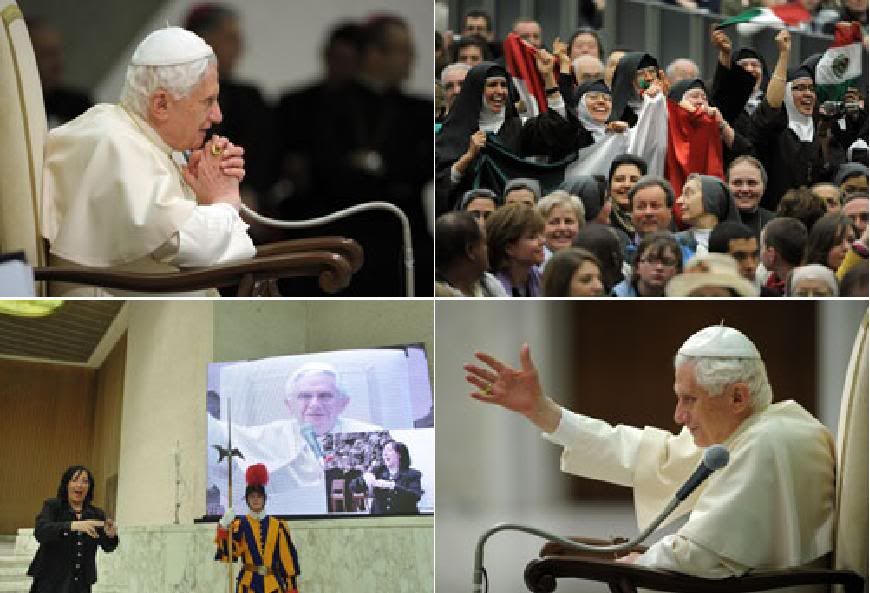 Here is a full translation of the catechesis:
Here is a full translation of the catechesis:
 Dear brothers and sisters,
Dear brothers and sisters,
St. Roberto Bellarmino, about whom I wish to speak to you today, brings us back to the time of a sad scission in Western Christianity, when a serious political and religious crisis provoked the detachment of entire nations from the Holy See.
Born on October 4, 1542, in Montepulciano, near Siena, he was a nephew, on his mother's side, of Pope Marcellus II. He had an excellent humanistic formation before entering the Society of Jesus on September 30, 1560.
His studies in philosophy and theology which he completed in the Collegio Romano, in Padua, and in Louvain, and which focused on St. Thomas Aquinas and the Fathers of the Church, were decisive for his theological orientation.
Ordained a priest on March 25, 1570, he was, for some years. a theology professor in Louvain. Subsequently, recalled to Rome to teach at the Collegio Romano, he was given the chair for Apologetics, In the decade that he had this position (1576-1586), he elaborated a course of lessons which later entered into Controversiae, a book which quickly became famous for its clarity and its wealth of contents, and its predominantly historical outlook.
The Council of Trent had just ended, and for the Catholic Church, it was necessary to reinforce and confirm her own identity especially with respect to the Protestant Reformation.
Bellarmino's activities were carried out in this context. From 1588 to 1694, he was first spiritual director of the Jesuit students in the Collegio Romano, among whom he met and guided the future St. Aloysius Gonzaga; then the religious superior.
Pope Clement VIII named him the pontifical theologian, consultor of the Holy Office, and rector of the College of Penitentiaries of St. Peter's Basilica. His catechism, the Dottrina cristiana breve, which was his most popular work, dates to this time.
On March 3, 1599, he was made a cardinal by pope Clement VIII, and on March 18, 1602, was named Archbishop of Capua. He received his episcopal ordination on April 21 that year.
During the three years that he was a diocesan bishop, he distinguished himself for his zeal as a preacher in his cathedral, for the visits that he made every week to his parishes, and for the three diocesan Synods and a provincial Council which he called.
After having participated in the conclaves that elected Pope Leo XI and Paul V, he was recalled to Rome, where he was a member of the Congregations of the Holy Office, the Index, Rites, Bishops, and Propagation of the Faith.
He also had diplomatic assignments to the Republic of Venice and to England, in defense of the rights of the Apostolic See.
In his final years, he wrote several books pf spirituality in which he condensed the fruits of his own annual spiritual exercises. Reading these, Christians even today can find them greatly edifying.
He died in Rome on Sept. 17, 1621. Pope Pius XI beatified him in 1923, canonized him in 1930, and proclaimed him Doctor of the Church in 1931.
San Roberto Bellarmino played an important role in the Church during the last decades of the 15th century and the early part of the following century. His Controversiae constituted a reference point that is still valid for Catholic ecclesiology on questions regarding Revelation, the nature of the Church, the Sacraments, and theological anthropology.
His work appears to emphasize the institutional aspect of the Church, in view of the errors which circulated at the time on such questions. Nonetheless, Bellarmino also clarified the invisible aspects of the Church as the Mystical Body and he illustrated these by an analogy to body and soul, to describe the relationship between the internal riches of the Church and the external aspects that make her perceptible.
In this monumental work, which attempted to systematize the various theological controversies of the era, he avoided every polemical and aggressive stand regarding the ideas of the Reformation, but using the arguments of reason and the Tradition of the Church, he illustrated Catholic doctrine in a clear and effective way.
However, his legacy lies mainly in the way he conceived of his work. The heavy demands of office did not, in fact, prevent him from tending daily to holiness with his fidelity to the demands of his own status as a religious, priest, and bishop.
From this fidelity arose his commitment to preaching. Being, as priest and bishop, first of all, a pastor of souls, he felt it was his duty to preach assiduously. There are hundreds of such sermones - homilies - in Flanders, in Rome, in Naples and in Capua, on the occasion of liturgical celebrations.
No less abundant are his expositiones and explanatione to parish priests, religious, students of the Collegio Romano, that often were on Sacred Scripture, especially the Letters of St. Paul. His preaching and catechesis present the same trait of essentialness which he had learned from his Ignatian education, which concentrates all the forces of the soul on the Lord Jesus, intensely known, loved and imitated.
In the writings of this man of governance, one is very clearly aware, despite the reserve behind which he masks his sentiments, of the primacy that he gives to the teachings of Christ.
Thus, San Bellarmino offers a model of prayer, the soul of every activity: prayer that listens to the Word of the Lord, which becomes mute in the contemplation of his grandeur, not folded in on the self, but ready to abandon oneself to God.
A distinctive sign of Bellarmino's spirituality was his living and personal perception of the immense goodness of God, in whom our saint felt himself truly a beloved child of God. For him, ti was a source of great joy to recollect himself, with serenity and simplicity, in prayer, in the contemplation of God.
In his book De ascensione mentis in Deum (Elevating the mind to God) composed following the scheme of St. Bonaventure's Itinerarium, he exclaims: "O my soul, your model is God, infinite beauty, light without shadows, splendorr that surpasses that of the moon and the sun: Raise your eyes to God in whom the archetype of all things is found, and from whom, as from a spring of infinite fruitfulness, comes the near infinity of things. And so you must conclude: whoever finds God, finds everything; who loses God, loses everything".
In this text one hears the echo of the famous contemplatio ad amorem obtineundum – contemplation to obtain love - from the Spiritual Exercises of St. Ignacio de Loyola. Bellarmino, who lived in the sumptuous and often unhealthy society of the late 16th and early 17th centuries, obtained from such contemplation practical applications to project the situation of the Church of his time with lively pastoral inspiration.
In the book De arte bene moriendi (The art of dying well), for instance, he cites as a sure standard for living well, as for dying well, frequent and serious meditation in which one must render an account to God of one's actions and one's way of living, and strive not to accummulate riches on earth, but to live simply and with charity, in order to accumulate goods in heaven.
In the book De gemitu columbae (The dove's lament), in which the dove represents the Church, he forcefully calls on the clergy and the faithful to a concrete and personal reform of their own life following what Scriptures and the saints teach - among whom he particularly cites St. Gregory Nazianzene, St, John Chrysostom, St. Jerome and St. Augustine, besides the great founders of religious orders like St. Benedict, St. Dominic and St. Francis.
Bellarmino taught with great clarity and with the example of his own life that there cannot be a true reform in the Church without, first, our personal reform and the conversion of our heart.
Bellarmino drew from St. Ignacio's Spiritual Exercises, advice on how to communicate profoundly even to the most simple minds, the beauty of the mysteries of the faith.
He wrote: "If you are wise, you will understand that you were created for the glory of God and for your eternal salvation. This is your destiny, this is the center of your soul, this is the treasure of your heart. Therefore, consider it a true good for yourself that which leads you to your goal, and as true evil that which makes you miss it.
"Prosperous and adverse events; wealth and poverty, sickness and health, honors and insults, life and death, the wise man should neither seek them nor flee them for what they are. But things are good and desirable only if they contribute to the glory of God and to your eternal happiness; they are bad and to flee from if they are in the way (De ascensione mentis in Deum, grad. 1).
Thsee are obviously not words which have gone out of fashion, but to be meditated on at length even today in order to orient our journey on this earth. They remind us that the end of our life is the Lord, God who revealed himself in Jesus Christ, in whom he continues to call us and to promise us communion with him.
They remind us of the importance of trusting the Lord, of giving one's all in a life faithful to the Gospel, of accepting and illuminating with faith and with prayer every circumstance and every activity of our life, always reaching out towarrds union with him. Thank you.;/DIM]
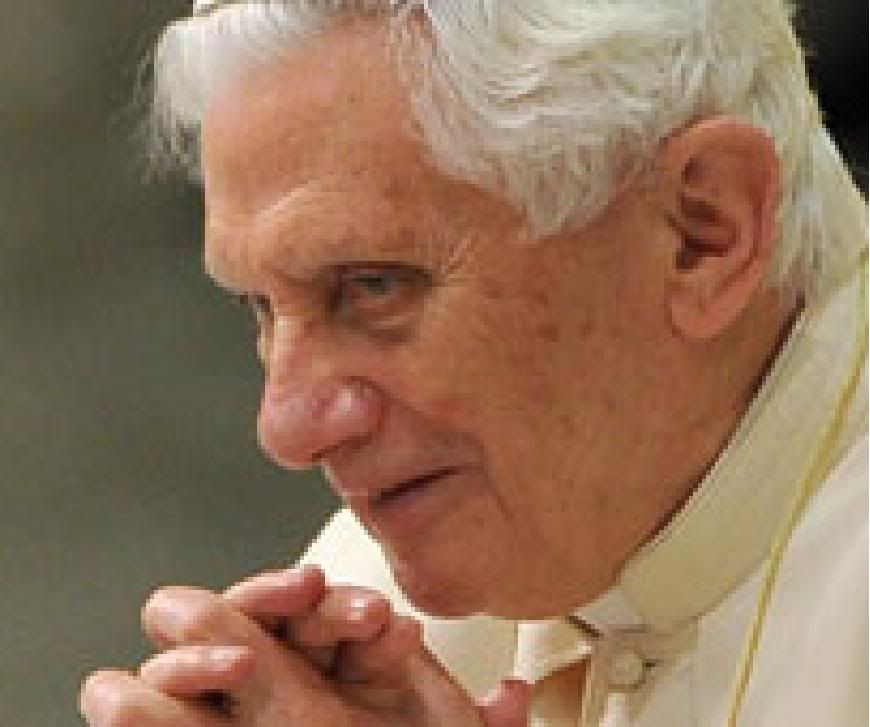
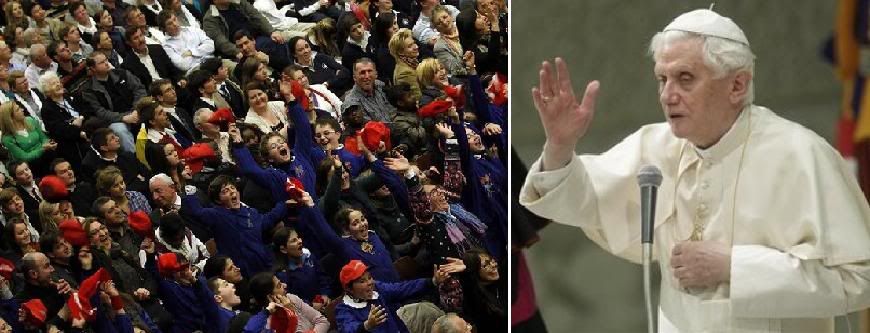
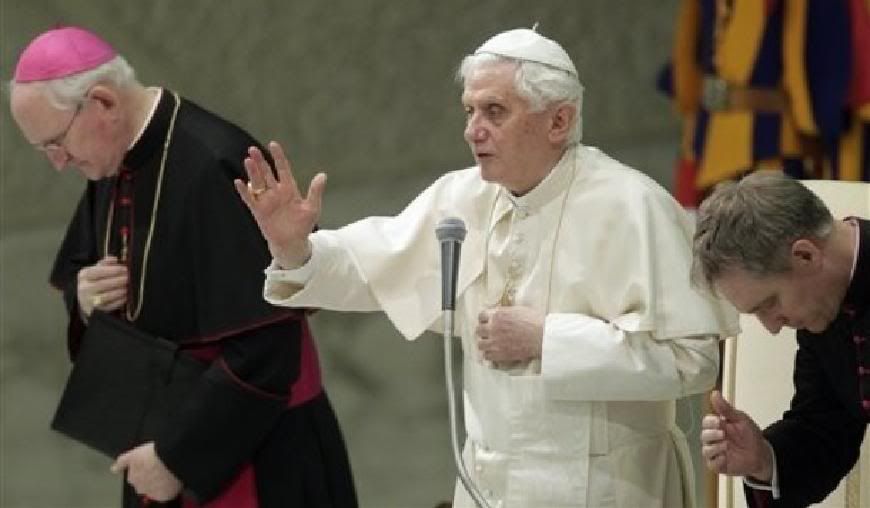
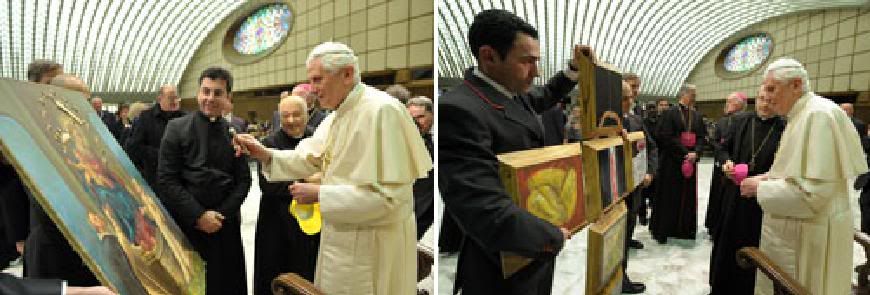
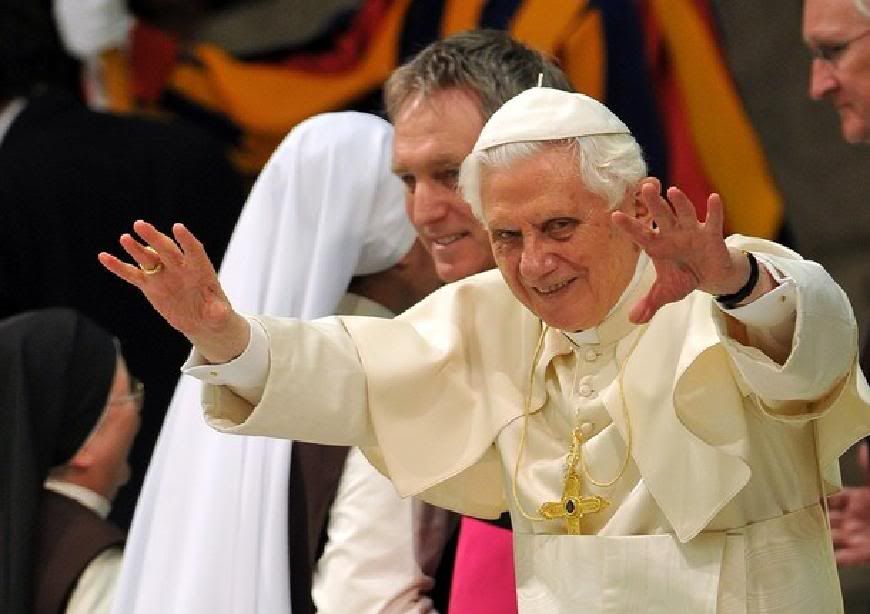
[Modificato da TERESA BENEDETTA 24/02/2011 17:52] |